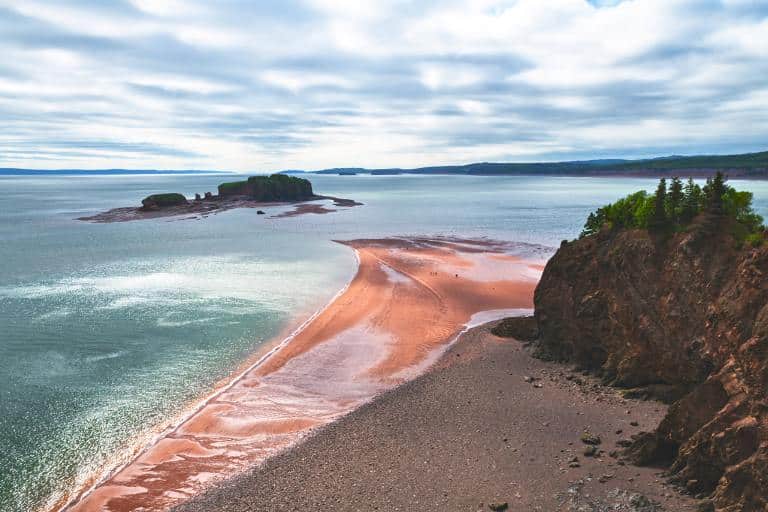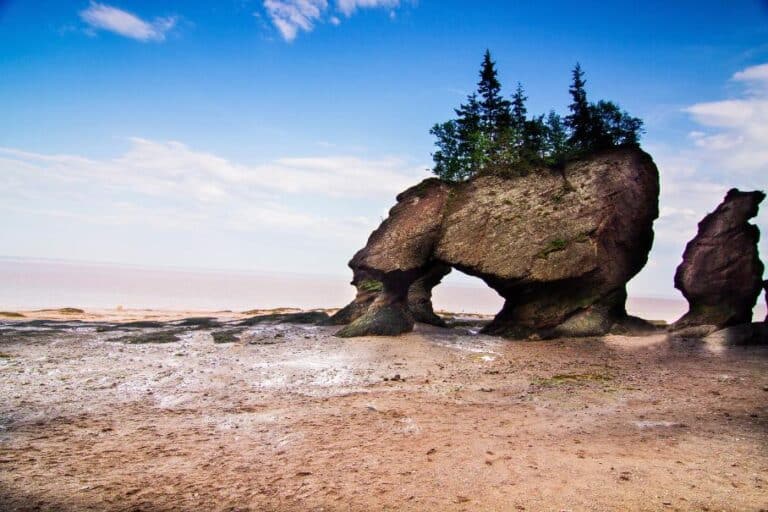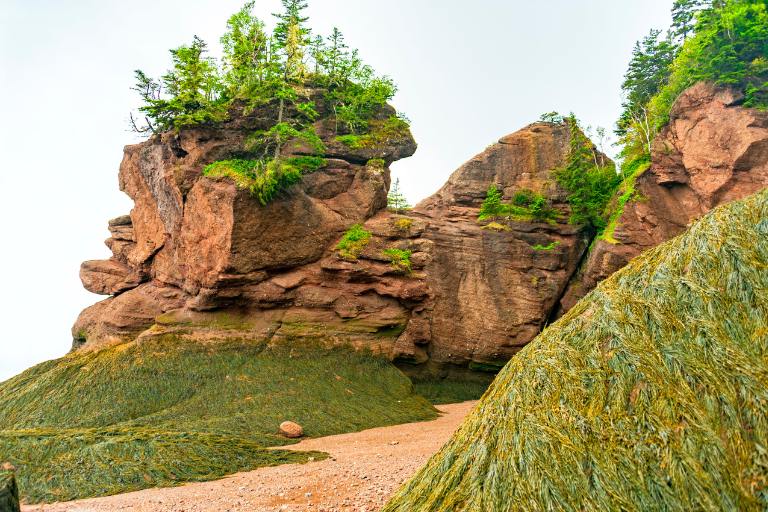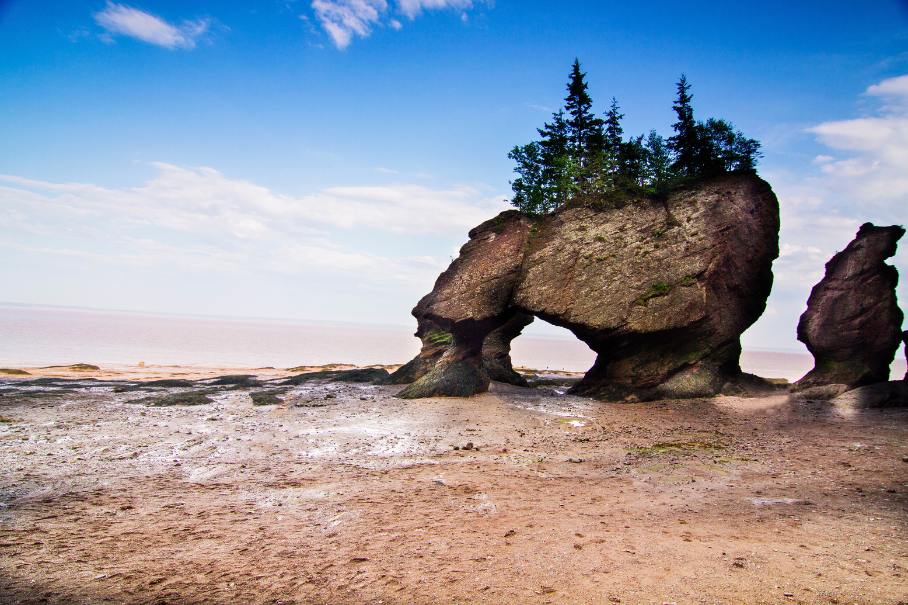Bay of Fundy: Experience the World’s Highest Tides
Canada is famous for its stunning landscapes, friendly people and rich Indigenous history. These are a few reasons why Canada is the ideal destination for all kinds of adventures. While there are many spectacular places for outdoor enthusiasts, none are like the Bay of Fundy, home of the world’s most extreme tides.
If you find yourself in Eastern Canada and are looking for a unique experience, then you should definitely add the Bay of Fundy to your travel list. Here’s what you need to know to make the most of your trip.
What is the Bay of Fundy?
The Bay of Fundy is a large inlet of the Atlantic Ocean in eastern Canada located between the provinces of New Brunswick and Nova Scotia. It’s famous for having the world’s highest tides, which can rise to 16.3 metres (53 feet). The bay spans approximately 170 miles of coastline. Here, you’ll find rugged cliffs, dense forests and unique rock formations carved by centuries of tidal action.
This natural area is home to Fundy National Park, with a diverse ecosystem that includes mudflats and coastal waters. Here, you can explore hiking trails winding through the thick Acadian forests and along the coast, as well as more than 25 waterfalls. If water is your thing, you can paddle in a kayak and experience the ever-changing tides or observe the wildlife.
Where is the Bay of Fundy located?
The Bay of Fundy forms the northwestern branch of the Bay of Fundy system along Canada’s Atlantic coast. This massive inlet stretches between two Maritime provinces, creating a natural beauty that draws visitors from around the world.
New Brunswick side
New Brunswick offers easy access to the bay’s most famous spots. The village of Alma sits right next to Fundy National Park. This small town makes a perfect base for exploring the area. You can drive here from Saint John in 1.5 hours or from Moncton in one hour.

The Fundy Trail Parkway on the New Brunswick side is a scenic 30-km drive. This route has 21 lookout points and four waterfalls. You’ll see the rugged coastline from high above the water.
Nova Scotia side
Nova Scotia has its own Bay of Fundy treasures. Blomidon Provincial Park sits on the shores of the Minas Basin. If you’re into hiking and camping, you’ll find plenty of opportunities here to do both. The Hopewell Rocks are also accessible from the Nova Scotia side during low tide.

The drive from Halifax takes about two hours to reach the bay. Public transportation doesn’t run directly to most bay areas, so you’ll need a car to explore fully. There are plenty of places to view the tides, so you’re not likely to encounter too many crowds.
The Famous Bay of Fundy tides
The Bay of Fundy has the world’s highest tides, which are truly amazing to witness. The process involves about 160 billion tons of seawater flowing in and out twice daily. It doesn’t happen very fast, so plan to spend some time there if you want to see the process in action.

For some reason, I had the wrong idea of what tides looked like before we got to the Bay of Fundy. I pictured them more like a wave, like what you see in surfing. When I realized how high they could get, I got a terrifying image of a tsunami-type wave that would bury me under the water. If you’re like me, don’t worry. It’s more like filling a tub with water or draining it.
Understanding how high and low tides work
High tide fills the bay with deep water, making it an ideal spot for kayaking or whale watching. During low tide, you can get a glimpse of the ancient ocean floor, where you can walk among rock formations carved by centuries of water. The tidal shifts happen every six hours and 13 minutes. You’ll see two high tides and two low tides every 24 hours. This timing means you can usually catch both during daylight hours.
Why are the tides so high in the Bay of Fundy?
The Bay of Fundy’s extreme tides are caused by its unique shape and size. The bay gets narrower and shallower as you move inland, which forces the incoming Atlantic Ocean water to rise higher and higher. Think of it like squeezing a water balloon – as the opening gets smaller, the water has to go somewhere, so it rises. The bay’s funnel shape amplifies the normal ocean tides.
Safety tips for experiencing the tides
The giant tide moves slowly, but don’t let that fool you into thinking there are no safety issues. The water rises faster than you might expect, and you might end up trapped. Always check tide tables before exploring. Stay aware of your surroundings and have an exit plan.
Check the official tide tables before you go
Stay on marked paths and avoid approaching wild animal habitats too closely. The rugged coastline has loose rocks and slippery surfaces. Always let someone know your plans if you’re hiking on remote trails. The Fundy Footpath requires serious preparation and should only be attempted by experienced hikers.
Top attractions and activities
The Bay of Fundy area offers activities to suit every type of traveller. From outdoor activities to cultural experiences, there’s something for everyone.
Fundy National Park
At 207 sq km, Fundy National Park is Canada’s smallest national park. It’s open year-round and is managed by Parks Canada. The park has over 80 km of trails. These old-growth forests are home to yellow birch trees and the world’s oldest known red spruce tree. You might spot white-tailed deer or even a black bear during your hike.
For detailed information about the route, fees, lookouts, observation decks, points of interest and maps, visit the Fundy Trail Parkway site.
The Fundy Footpath connects the park to the Big Salmon River. This challenging trail offers serious hikers a multi-day adventure along the Bay of Fundy coast. For easier options, try the Goose River Trail or other leisurely strolls near the visitor centre.
Wildlife and nature viewing
The park is home to a diverse array of wildlife. Here, you’ll find over 260 bird species and mammals as well as plant life you won’t see anywhere else. If you’re into birdwatching, consider visiting during spring migration, from April to June.
Whale watching
Whale watching is one of the bay’s top attractions, with the best time to see whales running from June through October. August and September offer peak viewing when humpback, fin and minke whales are most active in the bay’s rich waters.
Tourism New Brunswick has a great overview of the different tour companies running whale-watching tours. Check out the info on companies and whale watching before you go.
While orcas are rare in the Bay of Fundy, you might spot them during the late summer months. Whale-watching tours operate from both the New Brunswick and Nova Scotia sides, with costs varying depending on the tour length and operator. Many tours depart from Saint John, Grand Manan Island, and Digby, offering half-day and full-day options.
Your best chances of seeing whales are during the high tide, as the deeper water brings these massive creatures closer to shore. It’s also easier for the tour boats to get within a safe range to observe them.
Hopewell Rocks
The Hopewell Rocks are the bay’s most famous attraction. These towering rock formations look like giant flowerpots carved by the tides. At low tide, you can walk around their base and explore small caves.

At high tide, the same rocks become tiny islands. You can kayak around them or take an interactive tour with a guide. The visitor center features displays that explain how these formations evolved over thousands of years.
Fundy Trail Parkway
Another great way to experience the Bay of Fundy area is through the Fundy Trail Parkway. This scenic 30km (18-mile) drive offers access to 21 lookout points, seven beaches, nine points of interest, 16 observation decks and four waterfalls.
The route connects to hiking trails and biking trails. Don’t miss the Cape Enrage, one of the best spots for stunning views of the bay. You can also visit Walton Glen Gorge to see waterfalls and unique rock formations. For detailed information about the route, fees, lookouts, observation decks, points of interest and maps, visit the Fundy Trail Parkway site.
Culinary delights in Saint John
Saint John is a delightful place where you can start or end your tour of the Bay of Fundy. As a seaport city with a fascinating history and a laid-back atmosphere, Saint John is an ideal spot for foodies and those seeking relaxation.

Canada’s East Coast is known as a seafood destination, and if you’re looking to try some of the local flavours, you can’t go wrong here. Saint John alone has over 80 restaurants within a five-block radius, where you can feast on fresh lobster, steamed mussels, seafood chowder, and many other culinary delights.
Those craving additional local flavours should try dulse, a wild seaweed that resembles lettuce. This edible green is harvested on the nearby island of Grand Manan. It grows on ocean rocks and is harvested during low tide, then dried in the sun. Dulce is packaged and sold locally.
Tips for planning your visit
Timing and preparation make your Bay of Fundy trip more enjoyable. Here’s what you need to know before you go.
The best time to visit
The best time to visit depends on what you want to see and experience. Summer months offer the warmest weather and longest days. Late spring brings migrating birds and blooming flowers. Fall shows off colourful foliage in the Acadian forests.

The winter months bring cross-country skiing and a unique kind of beauty. The park remains open year-round, but some attractions are closed from November to April. Entrance fees are lower in winter.
Getting there and around
The bay sits between several nearby cities. Saint John is the largest city on the New Brunswick side of the province. Halifax provides access from Nova Scotia. Both cities have an international airport for flying visitors.

Public transportation is limited, but shuttle services are available from some hotels to major attractions. Google Maps works well for navigation, but cell service can be spotty in remote areas. Bus terminals in major cities connect to smaller towns. From there, you’ll need a car or a tour to reach the bay. Most attractions have parking lots, but it’s best to arrive early during peak season.
Where to stay
The village of Alma offers the closest accommodations to Fundy National Park. You can find many small inns and motels that provide overnight stays with local character. The area also has campgrounds for those who prefer camping. Saint John and Halifax offer a greater variety of hotel options and restaurants.
What to bring
Dress in layers, as the weather can change quickly near the water. Bring sturdy shoes for walking on wet rocks and mudflats. A cable ladder or rope might help with steep coastal access points. Pack snacks and water, as restaurants are scarce in remote areas. Bring a camera to capture the dramatic tidal shifts and rock formations. Don’t forget your binoculars if bird watching and wildlife viewing are on your must-do list.
Final thoughts
The Bay of Fundy offers spectacular views, but it’s the only place you can walk on the ocean floor that’s been there for millennia. When the low tide empties, it’s like peeking under a world we usually don’t see, from ancient life forms to rocky formations.
Here, you can feel like an explorer, venturing into a world that has long been forgotten. You can scour the ocean floor, kayak on the high tide or hike through ancient forests. Stand amongst the giant, silent rocks that make you feel small and insignificant. Now, you are an adventurer facing the power of nature. How cool is that?







